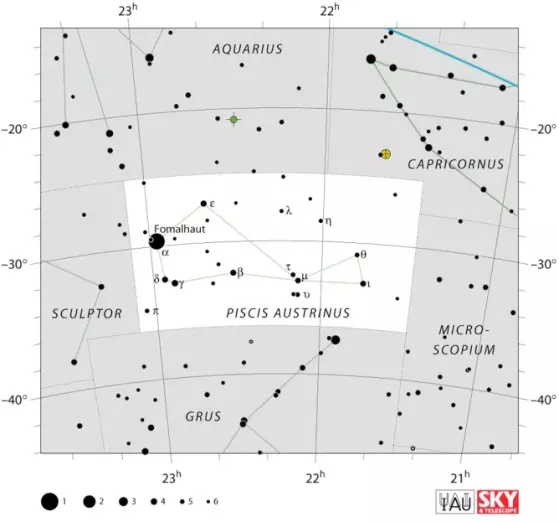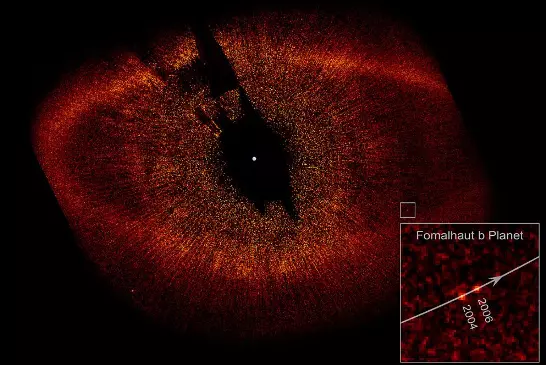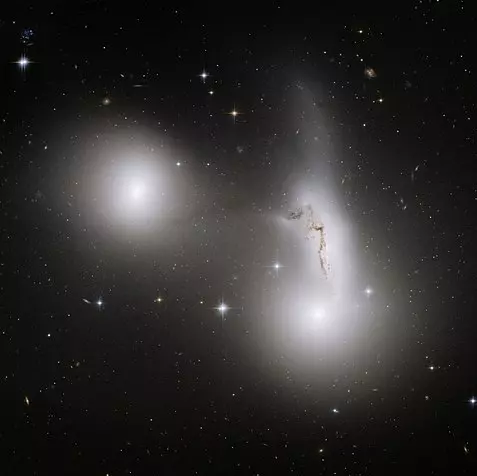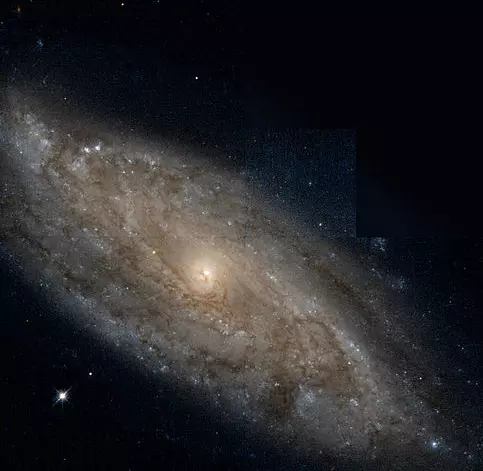Piscis Austrinus constellation lies in the southern sky. Its name means “the southern fish” in Latin.
The constellation is sometimes also called Piscis Australis. It was first catalogued by the Greek astronomer Ptolemy in the 2nd century CE, but its history dates back to Babylonian times. Until the 20th century, the constellation went by the name Piscis Notius. In the late 16th century, the Dutch astronomer Petrus Plancius separated some of its stars to form a new constellation, Grus.
Piscis Austrinus is a relatively small and faint constellation, with only one star brighter than fourth magnitude and not many notable deep sky objects. The brightest star in the constellation, Fomalhaut, is also one of the brightest stars in the night sky.
Facts, location and map
Piscis Austrinus is the 60th constellation in size, occupying an area of 245 square degrees. It is located in the fourth quadrant of the southern hemisphere (SQ4) and can be seen at latitudes between +55° and -90°. The neighboring constellations are Aquarius, Capricornus, Grus, Microscopium and Sculptor.
The constellation name Piscis Austrinus is pronounced /ˈpaɪsɪs ɔːˈstraɪnəs/. In English, the constellation is known as the Southern Fish. The genitive form of Piscis Austrinus, used in star names, is Piscis Austrini (pronunciation: /ˈpaɪsɪs ɔːˈstraɪnaɪ/). The three-letter abbreviation, adopted by the International Astronomical Union (IAU) in 1922, is PsA.
Piscis Austrinus belongs to the Heavenly Waters family of constellations, along with Carina, Columba, Delphinus, Equuleus, Eridanus, Puppis, Pyxis, and Vela.
Piscis Austrinus contains six stars with confirmed planets and does not have any Messier objects. The brightest star in the constellation is Fomalhaut, Alpha Piscis Austrini, with an apparent magnitude of 1.16. There are no meteor showers associated with the constellation.
Piscis Austrinus contains two formally named stars. The star names approved by the International Astronomical Union (IAU) are Fomalhaut (Alpha Piscis Austrini A) and Sāmaya (HD 205739).

Piscis Austrinus constellation map by IAU and Sky&Telescope magazine
Piscis Austrinus myth
Piscis Austrinus is one of the 48 Greek constellations, listed by the astronomer Ptolemy in his Almagest in the 2nd century CE. It used to contain the stars that now belong to Grus constellation.
The constellation has its origins in Babylonian culture, where it was known as the Fish, or MUL.KU. It was associated with the myth about the Syrian fertility goddess Atargatis, who fell into a lake near the river Euphrates in what is today northern Syria, and was rescued by a large fish. The goddess would later punish all those who ate fish, but her priests were allowed to eat it every day.
In a different version of the story, Atargatis deliberately threw herself into the lake. In this version, she abandoned her daughter, did away with the father, and was turned into a mermaid in the lake. Her daughter was brought up by doves and grew up to be Semiramis, the Assyrian queen.
The Greeks knew the constellation as the Great Fish and depicted it as swallowing the water poured by Aquarius, the water bearer. The two fish represented by Pisces constellation were said to be the offspring of the Great Fish.
In Greek mythology, there is a similar tale associated with Pisces. In the tale, the goddess Aphrodite took the form of a fish to hide from the monster Typhon. She and her son Eros and leapt into the river Euphrates and begged the river nymphs for help. Two fish bore them up and the goddess later honoured them by transforming them into the constellation Pisces.
Egyptians also associated the constellation with a fish, one that saved the life of the goddess Isis. To honour the fish, the goddess placed it into the sky as a constellation, and did the same with its offspring.
Piscis Austrinus stars
Fomalhaut – α Piscis Austrini (Alpha Piscis Austrini)
Fomalhaut, Alpha Piscis Austrini, is the brightest star in the constellation. With an apparent magnitude of 1.16, it is also the 18th brightest individual star in the night sky. It is a white main sequence star with the stellar classification of A3 V, approximately 25.13 light years from Earth.
Fomalhaut has 1.92 times the Sun’s mass and 1.842 times the solar radius. It is 16.63 times more luminous than the Sun. The star emits excess infrared radiation, which suggests that it has a circumstellar disk in its orbit. Fomalhaut is in fact surrounded by several debris disks.
The name Fomalhaut is derived from the Arabic fum al-ḥawt, which means “the mouth of the (Southern) Fish.” The star marked the solstice in 2500 BC. The Greek astronomer Ptolemy listed the star both in Piscis Austrinus and Aquarius, and in the 1600s Johann Bayer placed it firmly in Piscis Austrinus. In 1725, Flamsteed designed the star both 79 Aquarii and 24 Piscis Austrini, and the star was later placed in Piscis Austrinus by consensus.

Coronagraph of star Fomalhaut showing disk ring and location of extrasolar planet Fomalhaut b. Image: NASA, ESA, P. Kalas, J. Graham, E. Chiang, E. Kite (University of California, Berkeley), M. Clampin (NASA Goddard Space Flight Center), M. Fitzgerald (Lawrence Livermore National Laboratory), and K. Stapelfeldt and J. Krist (NASA Jet Propulsion Laboratory)
Fomalhaut belongs to the Castor Moving Group, a stellar association that also includes the bright stars Castor in Gemini and Vega in Lyra constellation. The stars in the group share a common motion through space and same location of origin, and they might be physically associated.
Alpha Piscis Austrini is notable for being the third brightest star with a confirmed object orbiting it, after Pollux in Gemini constellation and the Sun. The first stellar system with an extrasolar object, Fomalhaut b, was imaged at visible wavelengths in orbit around the star. Fomalhaut b is an extrasolar planet candidate discovered in 2008. It has an estimated orbital period of 2,000 years.
Fomalhaut and the star TW Piscis Austrini form a binary system.
TW Piscis Austrini
TW Piscis Austrini, also known as Fomalhaut B, is an orange dwarf star 24.9 light years distant from the Sun. It has the stellar classification of K5Vp. It is located within a light year of Fomalhaut and believed to be the bright star’s travelling companion.
TW Piscis Austrini is classified as a BY Draconis variable, a flare star that exhibits slight variations in brightness, ranging from magnitude 6.44 to 6.49, over a period of 10.3 days. The star has 0.725 times the Sun’s mass and 0.629 times the solar radius. It has only 19 percent of the Sun’s luminosity and a mean apparent magnitude of 6.48.
ε Piscis Austrini (Epsilon Piscis Austrini)
Epsilon Piscis Austrini is the second brightest star in the constellation. It is a blue-white main sequence dwarf belonging to the spectral class B8V. It has an apparent magnitude of 4.18 and is approximately 744 light years distant from Earth.
δ Piscis Austrini (Delta Piscis Austrini)
Delta Piscis Austrini is the third brightest star in Piscis Austrinus. It is really a multiple star system with the stellar classification G8III. The primary component in the system is a yellow giant. The system has an apparent magnitude of 4.20 and is about 170 light years distant from the Sun.
β Piscis Austrini (Beta Piscis Austrini)
Beta Piscis Austrini is only the fourth brightest star in the constellation. It is another multiple star system. It has an apparent magnitude of 4.29 and is approximately 148 light years distant from Earth. The system has the stellar classification of A1V, matching the spectrum of a white main sequence dwarf.
ι Piscis Austrini (Iota Piscis Austrini)
Iota Piscis Austrini is yet another multiple star system in Piscis Austrinus. It belongs to the spectral class B9.5V, and the primary star in the system is a B-type subgiant. The system has a visual magnitude of 4.35 and is about 205 light years distant from the Sun.
γ Piscis Austrini (Gamma Piscis Austrini)
Gamma Piscis Austrini is also a multiple star system. It has an apparent magnitude of 4.46 and is approximately 222 light years distant from the solar system. The system has the stellar classification A0III, and the brightest component is a white giant star, 81 times more luminous than the Sun.
μ Piscis Austrini (Mu Piscis Austrini)
Mu Piscis Austrini is a white main sequence star belonging to the stellar class A2V. It has an apparent magnitude of 4.50 and is approximately 130 light years distant from the solar system.
τ Piscis Austrini (Tau Piscis Austrini)
Tau Piscis Austriniis a yellow-white main sequence dwarf with the stellar classification of F6V. It has an apparent magnitude of 4.94 and is approximately 61 light years distant from Earth. The star is believed to be about 1.3 billion years old.
θ Piscis Austrini (Theta Piscis Austrini)
Theta Piscis Austrini is a multiple star system in the constellation. It has a visual magnitude of 5.02 and is about 339 light years distant from the solar system.
The primary component in the system is a white main sequence dwarf star belonging to the spectral class A1V.
π Piscis Austrini (Pi Piscis Austrini)
Pi Piscis Austrini is a spectroscopic binary star in Piscis Austrinus. The two stars in the system have a period of 178.3177 days. The system has an apparent magnitude of 5.12 and is approximately 93 light years distant from Earth.
η Piscis Austrini (Eta Piscis Austrini)
Eta Piscis Austrini is another multiple star system in Piscis Austrinus. It has an apparent magnitude of 5.43 and is approximately 1,012 light years distant from the Sun.
The primary component in the system is a blue-white subgiant star of the spectral type B8.
Lacaille 9352
Lacaille 9352 is the tenth closest star system to the Sun. It has an apparent magnitude of 7.34 and is only 10.68 light years distant. It is too faint to be seen without binoculars. The star has the spectral classification of M0.5V, matching the spectrum of a red dwarf. It has about half the Sun’s mass and 0.459 times the solar radius.
The star is also notable for having the fourth highest known proper motion, moving 6.9 arc seconds per year, and for being the first red dwarf to have its angular diameter measured.
HD 216770
HD 216770 is an orange main sequence dwarf with the stellar classification of K1V. It has an apparent magnitude of 8.10 and is approximately 123.5 light years distant from Earth. The star is slightly dimmer and cooler than the Sun.
A planet was discovered orbiting the star in 2003. It has 65 percent of Jupiter’s mass and completes an orbit around the star every 118.45 days. It is possible that there is another, smaller planet orbiting the star every 12.456 days, but its existence has yet to be confirmed.
S Piscis Austrini
S Piscis Austrini is a long period Mira variable, a pulsating variable star exhibiting variations in luminosity that range from magnitude 8.0 to 14.5 over a period of 271.1 days. The star is a red giant belonging to the spectral type M3e-M5IIe.
V Piscis Austrini
V Piscis Austrini is another variable star in Piscis Austrinus. It is a semi-regular variable showing variations in brightness ranging from magnitude 8.0 to 9.0 over a period of 148 days.
Deep sky objects in Piscis Austrinus
Hickson Compact Group 90 (HCG 90)
Hickson Compact Group 90 (HCG 90) is a group of galaxies approximately 100 million light years away. The group consists of the galaxies NGC 7173, NGC 7174, and NGC 7176. The galaxies are in the process of interacting and will eventually merge into a single large elliptical galaxy.

The three pictured galaxies — NGC 7173 (middle left), NGC 7174 (middle right) and NGC 7176 (lower right) — are part of the Hickson Compact Group 90, named after astronomer Paul Hickson, who first catalogued these small clusters of galaxies in the 1980s. NGC 7173 and NGC 7176 appear to be smooth, normal elliptical galaxies without much gas and dust. In stark contrast, NGC 7174 is a mangled spiral galaxy, barely clinging to independent existence as it is ripped apart by its close neighbours. The strong tidal interaction surging through the galaxies has dragged a significant number of stars away from their home galaxies. These stars are now spread out, forming a tenuous luminous component in the galaxy group. Image: NASA, ESA and R. Sharples (University of Durham, U.K.)
NGC 7173 is an elliptical galaxy with an apparent magnitude of 11.9. It lies about 114.8 million light years away. It was discovered by the English astronomer John Herschel on September 25, 1834.
NGC 7174 is a spiral galaxy with a visual magnitude of 12.5. John Herschel discovered it on September 28, 1834.
NGC 7176 is an elliptical galaxy. It has a visual magnitude of 11.5 and is approximately 115.5 million light years distant. It was the first of the three galaxies to be discovered by John Herschel, on September 23, 1034.
NGC 7314
NGC 7314 is a spiral galaxy with an apparent magnitude of 11.9. It is classified as a Seyfert (active) galaxy. The galaxy can be seen in a small telescope.

NGC 7314, image based on observations made with the NASA/ESA Hubble Space Telescope, and obtained from the Hubble Legacy Archive, which is a collaboration between the Space Telescope Science Institute (STScI/NASA), the Space Telescope European Coordinating Facility (ST-ECF/ESA) and the Canadian Astronomy Data Centre (CADC/NRC/CSA).
NGC 7172
NGC 7172 is a spiral galaxy with an apparent magnitude of 11.9. It is classified as a Seyfert 2 galaxy.